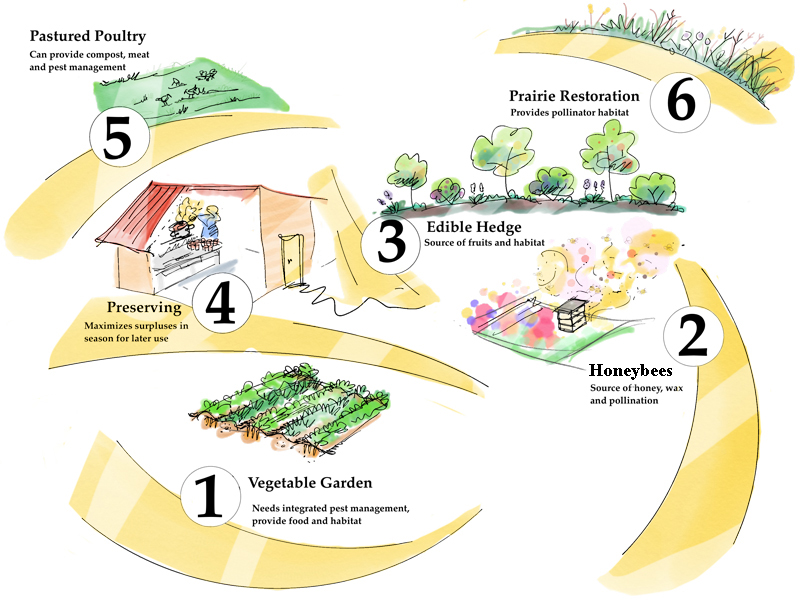
Over the years I have spoken with many growers, gardeners and homesteaders as both a friend and consultant. Most have very big dreams and ideals associated with living on the land, no matter the scale of their ambitions.
A big part of this is having a diverse production to meet their needs for the pantry, freezer and cellar. Homesteading after all is about self-sufficiency, right?
Probably the single biggest piece of advice I give to those who live on the land is this: Focus your goals to balance your time, energy and space. Less is more.
Keep It Simple
When we start a small farm or homestead, we want to do everything. We want chickens, sheep, an orchard, bees, gardens, ancient grain plots, etc.
Most people mention every productive enterprise possible when asked, “What is your goal for the land and your intended projects?” This is too much.
Not only will we fail to achieve all of these desired projects, but we will end up actually achieving less because we are stretched too thin. Each of these individual pursuits requires skills, time and money.
Instead, we should look to achieve a balanced production.
Do you have a farm plan? It’s especially important for small farms.
A Balancing Act
Your production should form a guild—a symbiosis of projects not unlike companion planting. I’ve termed this system a Guild Enterprise Production model (see my book The Permaculture Market Garden for more on that).
A Guild Enterprise Production model should:
- Suit your site, environment, climate and soil
- Contribute to your community by creating opportunities for trade and sale
- Balance labor across the seasons so you don’t have too much work in any one month
- Reuse seasonal waste to close the loop of regenerative productivity
- Share resources effectively by partitioning space, time and energy
For example, a farm could have three enterprises: garlic production, mixed vegetables and honey. Your garlic is planted in fall, while vegetables are spring planted. Thus, the intensive labour is spread across seasons.
Your bees create additional products in the form of honey , wax and propolis. This is enough. You don’t also need chickens, cows and orchards.
Down the road, when you master these enterprises, you will find ways of integrating and organizing to expand your diversity of production. You may grow less garlic and amalgamate it with your vegetable production as one enterprise. This could free up a production niche for a fruit enterprise.
This simplification is not a hard and fast rule, but it is a great guideline. And it is especially true for a sole operator. If you have more people working the land, then each could manage a few small-production enterprises. Still, no matter the scale, I wouldn’t do more than nine enterprises on any piece of land.
You land doesn’t need to meet your every need. Consider trading, bartering and selling to gain more products for your pantry, freezer and cellar.
Over my years as a market gardener, I always had plenty of organic cheeses, eggs, fruit, meat, veggies, honey, syrup and cut flowers. But I didn’t need to produce all these. Why? Because I had a reputation for the best root-cellar carrots in town.
I could sell as many as I could produce, and I traded the rest for what I needed.
Here’s everything you need to know about integrated pest management.
Guild of Stewardship
As a community, focusing on Guild Enterprise Production is a great strategy for resilience. Each community can balance nutrition, mixed-land use and area of focus to achieve lasting food security.Your garden has vegetable guilds, and your farm or homestead has a guild of enterprises. And so, too, can your community be a guild of stewards. The image below shows how different properties within a community can share production through trade and sale. It also illustrates how different productions can benefit each other within a larger community ecosystem.

Consider how compost can be shared between neighbors or how pollinator habitat in a prairie restoration plot can improve honey production and orchard yield.
Your enterprises can provide habitat for beneficial predators in your garden, while neighborhood poultry contribute to integrated pest management. Some neighbors can produce foods, while others preserve the harvest.
Again, the idea is this: If we focus on select production in our small farms, we can balance these with our neighbors for a complete community, both ecologically and culturally, to achieve food security and community resilience.
Every micro-landscape—whether a garden, greenspace or farm hedge—is an opportunity for integrated yield. By designing guilds in our enterprises to simplify management, we build relationships with our community members as fellow stakeholders in a common future.




